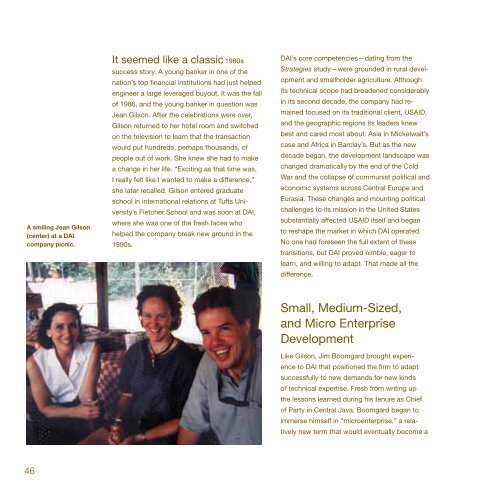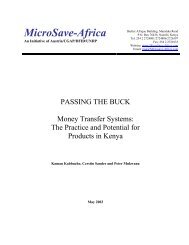You also want an ePaper? Increase the reach of your titles
YUMPU automatically turns print PDFs into web optimized ePapers that Google loves.
A smiling Jean Gilson<br />
(center) at a <strong>DAI</strong><br />
company picnic.<br />
46<br />
It seemed like a classic 1980s<br />
success story. A young banker in one <strong>of</strong> the<br />
nation’s top financial institutions had just helped<br />
engineer a large leveraged buyout. It was the fall<br />
<strong>of</strong> 1986, and the young banker in question was<br />
Jean Gilson. After the celebrations were over,<br />
Gilson returned to her hotel room and switched<br />
on the television to learn that the transaction<br />
would put hundreds, perhaps thousands, <strong>of</strong><br />
people out <strong>of</strong> work. She knew she had to make<br />
a change in her life. “Exciting as that time was,<br />
I really felt like I wanted to make a difference,”<br />
she later recalled. Gilson entered graduate<br />
school in international relations at Tufts University’s<br />
Fletcher School and was soon at <strong>DAI</strong>,<br />
where she was one <strong>of</strong> the fresh faces who<br />
helped the company break new ground in the<br />
1990s.<br />
<strong>DAI</strong>’s core competencies—dating from the<br />
Strategies study—were grounded in rural development<br />
and smallholder agriculture. Although<br />
its technical scope had broadened considerably<br />
in its second decade, the company had remained<br />
focused on its traditional client, USAID,<br />
and the geographic regions its leaders knew<br />
best and cared most about: Asia in Mickelwait’s<br />
case and Africa in Barclay’s. But as the new<br />
decade began, the development landscape was<br />
changed dramatically by the end <strong>of</strong> the Cold<br />
War and the collapse <strong>of</strong> communist political and<br />
economic systems across Central Europe and<br />
Eurasia. These changes and mounting political<br />
challenges to its mission in the United States<br />
substantially affected USAID itself and began<br />
to reshape the market in which <strong>DAI</strong> operated.<br />
No one had foreseen the full extent <strong>of</strong> these<br />
transitions, but <strong>DAI</strong> proved nimble, eager to<br />
learn, and willing to adapt. That made all the<br />
difference.<br />
Small, Medium-Sized,<br />
and Micro Enterprise<br />
Development<br />
Like Gilson, Jim Boomgard brought experience<br />
to <strong>DAI</strong> that positioned the firm to adapt<br />
successfully to new demands for new kinds<br />
<strong>of</strong> technical expertise. Fresh from writing up<br />
the lessons learned during his tenure as Chief<br />
<strong>of</strong> Party in Central Java, Boomgard began to<br />
immerse himself in “microenterprise,” a relatively<br />
new term that would eventually become a



